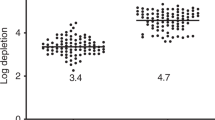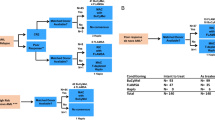Abstract
To reduce the number of apheresis procedures and maintain the usual rate of hematopoietic recovery in patients treated with high-dose chemotherapy, we studied the effect of adding a small volume of ex vivo expanded bone marrow to low doses of CD34+ blood stem cells. Thirty-four patients with breast cancer received G-CSF (10 μg/kg/day) priming followed by a limited volume (50–100 ml) bone marrow aspiration and standard 10-liter aphereses. Marrow was expanded ex vivo using the AastromReplicell system and infused along with low doses of blood-derived CD34+ cells, collected in one apheresis. Thirty-one evaluable patients received a median CD34+ blood stem cell dose of 0.7 × 106/kg (range, 0.2–2.5) and 4.7 × 107 nucleated cells/kg (range, 1.98–8.7) of ex vivo expanded marrow. All patients recovered with normal blood counts and engrafted 500 neutrophils/μl and 20 000 platelets/μl in a median of 10 and 13 days, respectively. Multivariate analysis revealed that, in addition to CD34+ lineage negative cell quantity, the quantity of stromal progenitors contained in the ex vivo expanded product correlated with engraftment outcome (r = 0.551, P = 0.004). Our results indicate that ex vivo expanded bone marrow is capable of facilitating engraftment when combined with low doses of mobilized blood derived CD34+ cells. Bone Marrow Transplantation (2001) 28, 295–303.
This is a preview of subscription content, access via your institution
Access options
Subscribe to this journal
Receive 12 print issues and online access
$259.00 per year
only $21.58 per issue
Buy this article
- Purchase on Springer Link
- Instant access to full article PDF
Prices may be subject to local taxes which are calculated during checkout


Similar content being viewed by others
References
Hartmann O, Gaelle LE, Corroller A et al. Peripheral blood stem cell and bone marrow transplantation for solid tumors and lymphomas: hematological recovery and costs Ann Intern Med 1997 126: 600–607
Sheridan WP, Begley CG, Juttner CA et al. Effect of peripheral-blood progenitor cells mobilized by filgrastim (G-CSF) on platelet recovery after high-dose chemotherapy Lancet 1992 339: 640–644
Chao NJ, Schriber JR, Grimes K et al. Granulocyte colony-stimulating factor ‘mobilized’ peripheral-blood progenitor cells accelerate granulocyte and platelet recovery after high-dose chemotherapy Blood 1993 81: 2031–2035
Watts MJ, Sullivan AM, Jamieson E et al. Progenitor-cell mobilization after low-dose cyclophosphamide and granulocyte colony-stimulating factor: an analysis of progenitor-cell quantity and quality and factors predicting for these parameters in 101 pre-treated patients with malignant lymphoma J Clin Oncol 1997 15: 535–546
Weaver CH, Hazleton B, Birch R et al. An analysis of engraftment kinetics as a function of the CD34 content of peripheral-blood progenitor cell collections in 692 patients after the administration of myeloblative chemotherapy Blood 1995 10: 3961–3969
Bensinger W, Appelbaum F, Rowley S et al. Factors that influence collection and engraftment of autologous peripheral-blood stem cells J Clin Oncol 1995 13: 2547–2555
Pecora AL, Preti RA, Gleim GW et al. CD34+ CD33− cells influence days to engraftment and transfusion requirements in autologous blood stem-cell recipients J Clin Oncol 1998 16: 2093–2014
Glaspy JA, Shpall EJ, LeMaistre CF et al. Peripheral blood progenitor cell mobilization using stem cell factor in combination with filgrastim in breast cancer patients Blood 1997 90: 2939–2952
Pecora AL . Impact of stem cell dose on hematopoietic recovery in autologous blood stem cell recipients Bone Marrow Transplant 1999 23: (Suppl. 2) S7-S12
Perez-Simon JA, Caballero MD, Corral M et al. Minimal number of circulating CD34+ cells to ensure successful leukapheresis and engraftment in autologous peripheral blood progenitor cell transplantation Transfusion 1998 38: 385–390
Weaver CH, Tauer K, Zhen B et al. Second attempts at mobilization of peripheral blood stem cells in patients with initial low CD34+ cell yields J Hematother 1998 7: 241–249
Gazitt Y, Freytes CO, Callander N et al. Successful PBSC mobilization with high-dose G-CSF for patients failing a first round of mobilization J Hematother 1999 8: 173–183
Brenner MK, Rill DR, Moen RC et al. Gene-marking to trace origin of relapse after autologous bone marrow transplantation Lancet 1993 341: 85–90
Deisseroth AB, Zu Z, Claxton D et al. Genetic markings shows that Ph+ cells present in autologous transplant CML contribute to relapse after ABMT in CML Blood 1994 83: 3068–3072
Rill DR, Santana VM, Roberts WM et al. Direct demonstration that autologous bone marrow transplantation for solid tumors can return a multiplicity of tumorigenic cells Blood 1994 84: 330–383
Stiff P, Chen B, Franklin W et al. Autologous transplantation of ex vivo expanded bone marrow cells grown from small aliquots following high-dose chemotherapy for breast cancer Blood 2000 95: 2169–2174
Lundell BI, Tyer C, DeSombre K et al. Ex vivo perfusion culture expansion of tumor positive bone marrow from breast cancer patients results in passive purging during the culture period Bone Marrow Transplant 1998 22: 153–159
Koller MR, Manchel I, Newsome BS et al. Bioreactor expansion of human bone marrow: comparison of unprocessed, density-separated, and CD34-enriched cells J Hematother 1995 4: 159–169
Koc ON, Gerson SL, Cooper BW et al. Rapid hematopoietic recovery after co-infusion of autologous-blood stem cells and cultured-expanded marrow mesenchymal stem cells in advanced breast cancer patients receiving high-dose chemotherapy J Clin Oncol 2000 18: 307–316
Lundell BI, Mandalam RK, Smith AK . Clinical scale expansion of cryopreserved small volume whole bone marrow aspirates produces sufficient cells for clinical use J Hematother 1999 8: 115–127
Sutherland DR, Anderson L, Kenney M et al. The ISHAGE guidelines for CD34+ cell determination by flow cytometry J Hematother 1996 5: 213–226
Ross AA, Cooper BW, Lazarus HM et al. Detection and viability of tumor cells in peripheral blood stem cell collections from breast cancer patients using immunocytochemical and clonogenic assay techniques Blood 1993 82: 2605–2610
Ross, AA, Moss TJ, Weintraub C et al. In vitro clonogenic growth of bone marrow micrometastasis from patients with breast cancer Breast Cancer Res Treat 1993 27: 169A (Abstr.)
Lowenthal RM, Tuck D, Tegg E et al. Hematopoietic stem-cell harvesting and transplantation using G-CSF-primed BM: comparison with unprimed BM and G-CSF-primed PBSC Cytotherapy 1999 1: 409–416
Tavassoli M, Friedenstein A . Hematopoietic stromal microenvironment Am J Hematol 1983 15: 195–213
Reese JS, Coc ON, Gerson SL et al. Human mesenchymal stem cells provide stromal support for efficient CD34+ transduction J Hematother 1999 8: 515–523
Gibson LF, Fortney J, Landreth KS et al. Disruption of bone marrow stromal cell function by etoposide Biol Blood Marrow Transplant 1997 3: 122–132
Hulmen DL, Verfaillie C, Jones RB et al. Treatment of marrow stromal monolayers reversibly alters hematopoiesis Br J Haematol 1991 78: 3304–3309
Migliaccio A, Migliaccio G, Johnson G et al. Comparative analysis of hematopoietic growth factor release by stromal cells from normal donors for transplant patients Blood 1990 75: 305–312
Fried W, Keto A, Barone J et al. Effects of cyclophosphamide and of busulfan on spleen colony-forming units and on hematopoietic stroma Cancer Res 1997 37: 1205–1209
McManus PM, Weiss L . Busulfan-induced chronic bone marrow failure: changes in cortical bone, marrow stromal cells, and adherence cell colonies Blood 1984 64: 1036–1041
O'Flaherty E, Sparrow R, Szer J et al. Bone marrow stromal function from patients after bone marrow transplantation Bone Marrow Transplant 1995 15: 207–212
Weaver A, Ryder D, Crowther D et al. Increased numbers of long-term culture-initiating cells in the apheresis product of patients randomized to receive increasing dose of granulocyte colony-stimulating factor Blood 1996 88: 3323–3328
Mandalam RK, Vento CA, Brott DA, Smith AK . Synergistic effects of thrombopoietin, SCF, and FLT3-L in ex vivo expansion cultures Exp Hematol 1998 26: 768 (Abstr.)
Malik S, Pecora AL, Preti RA et al. Engraftment after high-dose therapy for non-Hodgkin's lymphoma (NHL) with low doses of CD34+ peripheral blood stem cells and in vitro expanded bone marrow cells Blood 1999 94: 558A (Abstr.)
Stiff PJ . Management strategies for the hard-to-mobilize patient Bone Marrow Transplant 1999 23: (Suppl. 2) S29–S33
Haas RR, Mohle S, Fruhauf S et al. Patient characteristics associated with successful mobilization in autografting of peripheral blood progenitor cells in malignant lymphoma Blood 1994 83: 3787–3794
Demirer T, Bensinger WI, Buckner CD et al. Peripheral blood stem cell mobilization for high-dose chemotherapy J Hematother 1999 8: 103–113
Pecora AL, Preti RA, Lazarus HM et al. Breast cancer cell contamination of blood stem cell products in patients with metastatic breast cancer: predictors and clinical outcomes Blood 1999 94: 665A (Abstr.)
Acknowledgements
Research support was provided by Aastrom Biosciences, Inc. The authors wish to acknowledge the work of Patricia Price, RN for her assistance in patient care and data management and Hillars Lazarus, MD for his thoughtful review of the manuscript.
Author information
Authors and Affiliations
Rights and permissions
About this article
Cite this article
Pecora, A., Stiff, P., LeMaistre, C. et al. A phase II trial evaluating the safety and effectiveness of the AastromReplicell system for augmentation of low-dose blood stem cell transplantation. Bone Marrow Transplant 28, 295–303 (2001). https://doi.org/10.1038/sj.bmt.1703137
Received:
Accepted:
Published:
Issue Date:
DOI: https://doi.org/10.1038/sj.bmt.1703137
Keywords
This article is cited by
-
Ex vivo expansion of umbilical cord blood: where are we?
International Journal of Hematology (2012)
-
Ex vivo expansion of cord blood
Bone Marrow Transplantation (2009)
-
Determination of the Fate and Contribution of Ex Vivo Expanded Human Bone Marrow Stem and Progenitor Cells for Bone Formation by 2.3ColGFP
Molecular Therapy (2009)
-
Evaluation of ex vivo expansion and engraftment in NOD-SCID mice of umbilical cord blood CD34+ cells using the DIDECO ‘Pluricell System’
Bone Marrow Transplantation (2005)
-
Cost–effectiveness of repeated aphereses in poor mobilizers undergoing high-dose chemotherapy and autologous hematopoietic cell transplantation
Leukemia (2003)



